Exhibition place:The National Museum Sultanate of Oman
Exhibition time:2018.10 - 2018.11
Silk, Tea and Celadon: Intercultural Dialogue on the Silk Road
الحرير، والشاي والخزف: حوار عبر الثقافات في طريق الحرير
Foreword
Silk, tea and porcelain came into being in ancient China, reflecting the profound wisdom and traditional techniques of the Chinese. After years of land and sea transportation, they eventually spread all over the world, becoming “Seres”, “Celadon” and “Tea” of Western people. Many years later, the long and arduous sea and land routes were collectively referred to as ‘the Silk Road’. No one could imagine that these Chinese gifts, which symbolise the aesthetics of oriental life, take root in different regions, influence the world’s economic and cultural patterns in different historical periods, and change the life style and quality of mankind forever.
مقدمة
نشأ الحرير والشاي والخزف في الصين القديمة ليعكس الحكمة العميقة والتقنيات التقليدية عند الصينيين، وبعد سنوات طويلة من النقل البري والبحري، انتشر الحرير والشاي والخزف في جميع أرجاء العالم، وتحورت لتسمى سيريس وسيلادون وشاي وتنسب إلى الأوروبيين. وبعد عدة سنوات، أصبحت هذه الطرق البرية والبحرية الصعبة تعرف باسم "طريق الحرير"، ولم يتوقع أي شخص أن هذه الهدايا الصينية التي تمثل مظاهر جماليات الحياة الشرقية قد تتأصل في مناطق مختلفة وتؤثر على الأنماط الاقتصادية والثقافية للعالم على مدى فترات تاريخية مختلفة، ناهيك عن تغيير نمط حياة ومعيشة البشر للأبد.
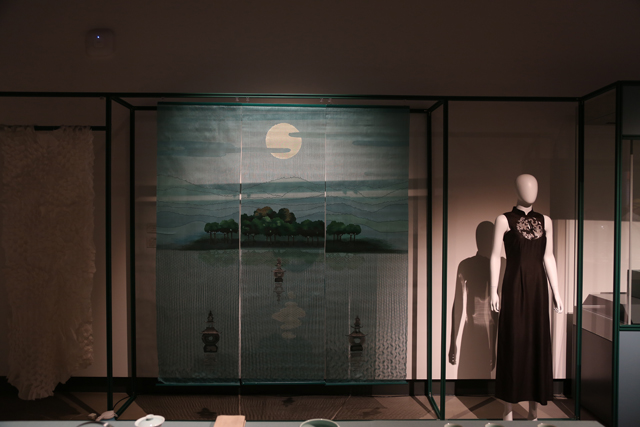
Unit 1: Origin: Hometown China
Thousands of years ago, when Chinese firstly cultured silkworms and weaved silk, kneaded clay to sinter utensils, and discovered tea trees and picked tea leaves, probably nobody expected that the soft fabric, emerald porcelain and fragrant drink in ancient China would eventually go through time and space and become the treasures of the world.
الموطن؛ الصين
قبل آلاف السنين، عندما بدأ الصينيون بتربية دودة القز ونسج الحرير وتشكيل الخزف لأوعية صلبة واكتشاف أشجار الشاي وقطف أوراق الشاي؛ لم يُتَوقع أن هذا القماش الناعم والخزف الزمردي والشراب العطر في الصين القديمة سوف يستمر عبر الزمان والمكان ويصبح من ثروات العالم.

• Country of Silk
Silk is the product made by human beings using strings from the silk cocoons. It has undergone a long process from the usage of cocoon silk of wild silkworms to domestication of wild silkworms, and to cultivation of mulberry trees. All early silks made from cocoons of domestic silkworms were discovered in China, which indicates that China is the origin of silk in the world.
بلد الحرير
الحرير هو منتج يصنعه البشر باستخدام خيوط من شرنقة دودة القز، وقد خضع لعملية طويلة بدءً من استخدام خيوط حرير شرنقة دودة القز البرية وحتى تربية دودة القز وحصد أشجار التوت. وقد اكتشف جميع الحرير المصنوع من دودة القز المستأنسة في الصين؛ مما يشير إلى أن الصين هي موطن الحرير الأول في العالم.
Origin of Silk
More than 5,000 years ago when the Chinese started to culture silkworms and weave silk in the mainland, mainly in the Yellow River Basin and Yangtze River Basin, silk was born. Taking mulberry trees and silkworms as the medium for communication between heaven and man, the ancestors often used silk to make shroud, sacrificial garments and funeral ritual supplies for “ghosts and gods”.
منشأ الحرير
قبل أكثر من 5000 عام عندما بدأ الصينيون بتربية دودة القز ونسج الحرير في بر الصين الرئيسي، خاصة على ضفاف النهر الأصفر ونهر يانغتسي؛ عندها نشأ الحرير. وحيث أن الصينيين يعتقدون بأن أشجار التوت ودودة القز هي وساطة للحوار بين السماوات والإنسان، فقد استخدم القدماء الحرير لصنع الأكفان ومستلزمات الجنائز للأرواح والآلهة.
○ In ancient China, silk invention was generally attributed to Leizu, the First Consort of the Yellow Emperor, who taught people how to culture silkworms.
في الصين القديمة، قيل بأن اكتشاف الحرير يعود إلى "ليزو"؛ زوجة الإمبراطور الأصفر والتي علَّمت أفراد الشعب طريقة تربية دودة القز.
○ Half a silk cocoon unearthed at the Yangshao Culture Site in Xiyin Village, Xiaxian County, Shanxi Province in 1926 CE empirically proves the utilization of silk cocoons by human beings.
أثبت اكتشاف نصف شرنقة دودة قز مدفونة في موقع حضارة يانغ-شاو بقرية كوشي في إقليم كوشي كوسوان بمقاطعة شانشي عام 1926م استخدام البشر لشرنقة دودة القز.
○ The domestic silkworm threads, silk ribbons and silk pieces discovered at the Qianshanyang Site (2200 BCE) in Huzhou City, Zhejiang Province in 1958 CE empirically prove that silk appeared in the Yangtze River Basin.
أثبت اكتشاف خيوط حرير دودة القز المستأنسة وأشرطة الحرير وقطع الحرير في موقع تشايان سان يانغ (2200ق.م.) بمدينة هوتشو بمقاطعة جيتيانغ عام 1958م بأن الحرير ظهر في ضفاف نهر يانغتسي.
○ The silk fragments in an urn burial unearthed from the site at Qingtai Village (4000 BCE), Xingyang, Henan Province in 1983 CE empirically proves that silk appeared in the Yellow River Basin.
أثبت اكتشاف بقايا الحرير في جرة دفن بقرية قانتون (4000ق.م.) بشينغيانغ بمقاطعة هينان عام 1983م بأن الحرير ظهر على ضفاف النهر الأصفر.
Silk Varieties
Through thousands of years, silk has developed into many kinds, which can be divided into woven silk, dyed silk and embroidered silk among others according to techniques and textures. Woven silk can be further divided into damask silk, silk gauze, silk fabric, satin, spun silk, down fiber, brocade and silk tapestry with cut designs etc.
أنواع الحرير
عبر آلاف السنوات، تطور الحرير إلى عدة أنواع يمكن تقسيمها إلى الحرير المحيوك، والحرير المصبوغ، والحرير المطرز وغيرها وذلك وفقا للتقنيات المستخدمة والنسيج، ويمكن تقسيم الحرير المحيوك إلى الحرير الدمقس وحرير الشاش وحرير القماش والساتان والحرير المغزول والموشى والمطرز وغيرها.
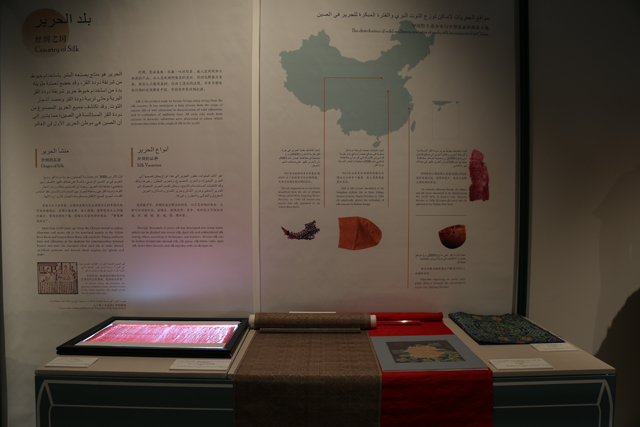
State of Celadon
Celadon, one of the porcelain that was the first to be successfully sintered, is so named because of its cyan colour. China is the first country to invent porcelain, more than three thousand years before the setup of the first porcelain factory in Venice, Italy.
دولة السيلادون
السيلادون، أحد أنواع الخزف الأولى التي صلبت بنجاح، وسمي نسبة للونه الأزرق المخضر، وتعد الصين هي أول دولة تخترع السيلادون وذلك قبل أكثر من ثلاثة آلاف عام من إنشاء أول مصنع خزف في البندقية بإيطاليا.
Origin of Celadon
From about the Xia and Shang Dynasties, the proto-celadon appeared at the Dongtiaoxi Basin, Zhejiang Province in South China. In the middle and late Eastern Han Dynasty, mature celadon was firstly sintered in the middle reach of the Cao’s River.
Celadon varieties
Through the long years, different factions and kilns of Chinese celadon have been developed, with unique style in glazes and shapes. The most famous kilns include Yue Kiln, Yaozhou Kiln, Ru Kiln, Jun Kiln, Southern Song Dynasty Guan Kiln, Longquan Kiln etc., among which Longquan Kiln reached the peak in celadon technology.
أنواع السيلادون
خلال سنوات طويلة، تطورت أنواع مختلفة من أفران السيلادون الصيني بأنماط تزجيج وأشكال مميزة، وأشهر هذه الأفران فرن يوي، وفرن ياوزهو، وفرن رو، وفرن جون، وفرن أسرة غوان، وفرن لونغكوان والذي بلغ ذروة تقنيات السيلادون.
□Yue Kiln
Yue Kiln got prospered in the Tang and Song Dynasties, with the sites being distributed mainly in Shanglin Lake, Cixi City, Zhejiang Province, Yaosiqian Site of Shangyu, Dongqian Lake in Ningbo, etc. Products out of Yue kilns are antique, quiet and tasteful in color and have jade-like texture, among which the “secret color porcelain” is the most famous.
لقد انتعش فرن يوي خلال فترة أسرتي تانغ وسونغ وانتشر إلى بحيرة شانغلين، ومدينة تسيشي، ومقاطعة جيتيانغ، وموقع ياو سي شيان بشانغيو، وبحيرة دونغكيان بننغبو. وتعد منتجات أفران يوي عتيقة وجميلة وغنية بالألوان وملمس أشبه بالزبرجد؛ ويعد "الخزف ذو اللون السري" أشهر أنواعها.
□Yaozhou Kiln
Yaozhou Kiln appeared in the Tang Dynasty and got prospered in the Song Dynasty. The kiln site was located in Huangbao Town, Tongchuan City, Shaanxi Province, where unique and featured celadon with carved design and printed flower abound in. Yaozhou Kiln is the representative of northern celadon.
ظهرت أفران ياوزهو خلال فترة سلالة تانغ وانتشرت في فترة سلالة سونغ، وكان موقع الفرن في بلدة هوانغباو بمدينة تونغتشوان بمقاطعة شنشي حيث ظهر السيلادون ذو التصاميم المحفورة والأزهار المطبوعة، ويعد فرن ياوزهو رمزا للسيلادون الشرقي.
□ Ru Kiln
Ru Kiln is the most famous celadon kiln site in the late Northern Song Dynasty. Precious agate was added to the glaze of Ru Kiln celadon; pure azure is the predominant colour; the glaze fluid is thick, smooth and bright, and the shape is antique and elegant.
فرن رو
يعد فرن رو أشهر مواقع أفران السيلادون في أواخر فترة سلالة سونغ الشمالية، وقد استخدم حجر العقيق في عملية تزجيج سيلادون فرن رو ليكتسب اللون اللازوردي، وسائل التزجيج سميك وناعم ولامع، والشكل عتيق وأنيق.
□Southern Song Dynasty Guan Kiln
When the South Song Dynasty founded its capital in Lin’an (now called Hangzhou), Department of Palace Supply Kiln and Altar of Heaven Kiln were established to specially produce royal utensils, which were therefore called the “Southern Song Dynasty Guan Kiln”. This Klin is unique in the light greenish blue glaze colour and the shape, famous for the crackles, and its products are solemn and elegant as jade.
فرن غوان لسلالة سونغ الجنوبية
عندما أسست سلالة سونغ الجنوبية عاصمتها في لينان (هانغزهو حاليا)، تم تأسيس دائرة دعم أفران القصر وفرن ممشى السماوات خصيصا لإنتاج الخزف الملكي الذي تمت تسميته "فرن غوان لسلالة سونغ الجنوبية"، ويتميز هذا الفرن بإنتاج خزف مزجج ذي لون أخضر-أزرق فاتح، وهو مشهور بالأواني الخزفية المجزعة ومنتجاته بهية كبهاء اليشم.
□ Longquan Kiln
As a masterpiece of celadon technology in ancient China, Longquan Kiln is featured by the longest sintering time, the widest distribution, and the largest production scale and its products were sold in the widest areas. The product is of simple, unsophisticated and demure shape and in gentle glaze colour. Among others, the light greenish blue and plum green ones are the most charming.
فرن لونغكوان
يمثل فرن لونغكوان تحفة تقنية السيلادون في الصين القديمة، وكانت إنتاجاته الهائلة تباع في مناطق شاسعة؛ إذ كانت بسيطة وغير معقدة وذات تزجيج رقيق، وكانت أشهر ألوانها الأزرق المخضر الفاتح والغامق.
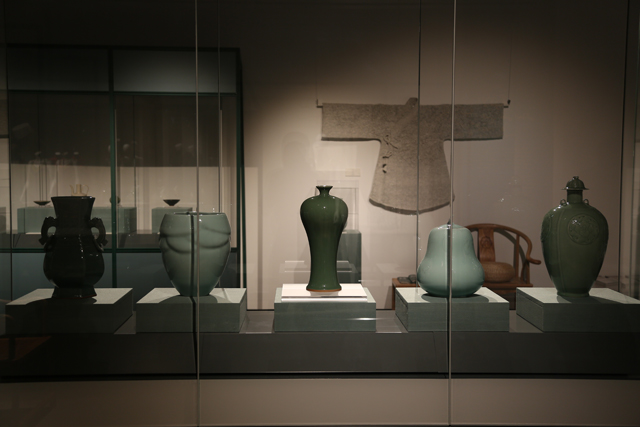
• Hometown of Tea
Tea ranks first among the seven plants that change the world. Tea trees are planted in over 60 countries and about 2 billion people drink tea in over 150 countries. China is the first country to discover and utilize tea; and it has been proved that all varieties of tea, and tea culture, in the world were spread directly or indirectly from China.
موطن الشاي
يعد الشاي من بين أول سبع نباتات غيرت العالم، وتزرع أشجار الشاي في نحو 60 دولة ويشربه حوالي ملياري شخص في أكثر من 150 دولة، وتعد الصين أول دولة اكتشفت واستخدمت الشاي حيث انتشرت ثقافة الشاي في العالم بشكل مباشر أو غير مباشر عن طريق الصين.
Origin of Tea
Tea was discovered and utilized in ancient times. So far, over 200 places of ancient tea trees have been found in 10 provinces in China. Among them, the big tea tree on Ailao Mountain in Yunnan is the oldest wild tea tree found so far. It can be seen that tea trees originated from the mountainous areas in southwest China, and that China is the hometown of tea.
أصل الشاي
اكتشف حتى الآن أكثر من 200 موقع لأشجار الشاي القديمة في 10 مقاطعات بالصين، ومن بينها شجرة شاي ضخمة في جبل آيلاو بمنطقة يونان تعد أقدم شجرة عثر عليها حتى الآن، مما يثبت أن أصول شجرة الشاي تعود إلى الجبال في جنوب غرب الصين وأن الصين هي موطن الشاي الأصلي.
Six Major Tea Categories
أنواع الشاي الستة الأساسية
Over several thousand years of production, the Chinese tea growers have accumulated rich experience in picking and making tea, resulting in a variety of famous tea. Chinese tea can be divided into six major categories according to the making methods, namely green tea, black tea, oolong tea (cyan tea), yellow tea, white tea and dark tea.
على مدى آلاف السنوات من الإنتاج، اكتسب مزارعو الشاي الصينيون خبرة كبيرة في قطف الشاي وصنعه مما نتج عنه وجود أنواع عدة من الشاي الشهير، ويمكن تقسيم الشاي الصيني إلى ستة أصناف أساسية وفقا لطريقة الصنع وهي: الشاي الأخضر، والشاي الأسود، وشاي الأولونج، والشاي الأصفر، والشاي الأبيض والشاي الداكن.
○Green tea: The output and varieties of Chinese green tea rank the first around the world. It is a kind of non-fermented tea, featured by clear soup and green leaves after brewing. There are typical green tea types such as Hangzhou West Lake Longjing tea, Biluochun Tea from Jiangsu Province, Huangshan Maofeng tea from Anhui Province, and Xinyang Maojian tea from Henan Province.
الشاي الأخضر:
تعد أصناف الشاي الأخضر الصيني أجود الأنواع على مستوى العالم، إذ إنها غير متخمرة وتنتج شايا نقيا وأوراق خضراء بعد إعدادها. ومن أنوع الشاي الأخضر المعروفة شاي لونغ جينغ في غرب بحيرة هانغتشو، وشاي بي لون شو من مقاطعة جيانغسو، وشاي هوانغشان ماوفينغ من مقاطعة آنهوي، وشاي شينيانغ من مقاطعة هينان.
○Black tea: Black tea is a fully fermented tea, with the highest output and sales volume around the world. The Chinese black tea is divided into Souchong, Congou and broken black tea based on their manufacture method and quality.
الشاي الأسود: وهو شاي متخمر تمامًا وهو الأكثر مبيعًا حول العالم، ويقسم الشاي الأسود الصيني إلى سوشونغ، وكونغو، والشاي الأسود المفتت وذلك وفقًا لطريقة الصنع والجودة.
○Oolong tea: As a special kind of Chinese tea, it has strong flower and fruit aromas. The representative products include Fujian Wuyi rock tea, Anxi Tieguanyin tea, Guangdong Fenghuang Dancong and Taiwan Pouchong tea.
شاي أولونغ:
نوع خاص من الشاي الصيني؛ لأزهاره وثماره رائحة نفاذة، وتتضمن أنواعه شاي جبل فوجيان يويي، وشاي إنكسي تيغوانيان، وشاي غواندونغ فينغوانغ دانكونغ، وشاي بوشونغ تايوان.
○Yellow tea: Based on the tenderness and sizes of raw materials, the yellow tea can be divided into yellow bud tea, small yellow tea and large yellow tea. Junshan Yinzhen is the representative from Yueyang in Hunan province.
الشاي الأصفر: يمكن تقسيم الشاي الأصفر وفق نعومته وحجم أوراقه إلى شاي البراعم، والشاي الصغير، والشاي الكبير، ويعود شاي جونشان ينزين إلى يوييانغ بمقاطعة خونان.
○White tea: No frying or rolling is required for processing white tea. As a slightly fermented tea, it is fully covered with white fuzz. The infusion is bright yellow, fresh and mellow. There are Baihao Yinzhen, Baimudan, Shoumei, Gongmei as famous products.
الشاي الأبيض: ينتج الشاي الأبيض دون الحاجة إلى القلي أو التقليب، وهو شاي قليل التخمر ويغطيه زغب أبيض، ومن أشهر أنواعه بايهو ينزين، وبايمودان، وشوميه، وغونغميه.
○Dark tea: As a special kind of Chinese tea, it is produced mainly in Hunan, Yunnan, Sichuan, Hubei, Guangxi, etc. The re-processed tea, including scented tea, compressed tea, etc., is made from various kinds of primary tea or refined tea.
الشاي الداكن: وهو نوع خاص من الشاي الصيني وينتج بشكل خاص في خونان، ويونان، وسيتشوان، وخوبي، قوانغشي. وينتج الشاي المعالج باستخدام أنواع من الشاي الأساسي أو المصفى.
Unit 2: Road: Transmission and Communication
Silk, tea and porcelain were spread to all parts of the world along the Land Silk Road or the Maritime Silk Road with camel bells or sails. This is not only the Silk Road, but also the Porcelain Road and the Tea Road.
الطريق: النقل والتواصل
انتشر الحرير والشاي والخزف إلى جميع أنحاء العالم عبر طريقي الحرير البري والبحري مرتحلة في قوافل الجمال والسفن. ولا يقتصر مسمى هذا الطريق على طريق الحرير؛ بل يمكن تسميته طريق الخزف وطريق الشاي.
The Silk Road
The Silk Road was put forward by a German geologist Baron Ferdinand von Richthofen in 1877. Narrowly speaking, it specially refers to the vital communication line between the ancient Greece in Europe and oriental China, leading to Seres. Broadly speaking, the Silk Road is collectively referred to the commercial trade and cultural exchange lines which have been formed gradually since the ancient times, are mainly oriented toward the communication between the East and the West, are widely distributed in the Eurasia even some areas of Africa, including the Silk Road of Prairie that got flourishing about the 9th to 3th Century BCE, the Silk Road of Desert Oasis that reached the peak between the Han and Tang Dynasties, Maritime Silk Road that had been playing an important role after the Song and Yuan Dynasties, etc. At the meeting of the 38th World Heritage Committee held in Doha on June 22, 2014 CE, the “Silk Road: Chang’an-Tianshan Corridor” jointly declared by three countries,namely China, Kazakhstan and Kyrgyzstan, was listed as a world heritage by the UNESCO.
طريق الحرير
في عام 1877م، أطلق الجغرافي الألماني البارون فرديناند فون ريتشهوفن مسمى طريق الحرير على الطرق الحيوية الواصلة بين اليونان القديمة في أوروبا والصين الشرقية. وبشكل عام، يشير طريق الحرير إلى مسار التبادل التجاري والثقافي الذي نشأ تدريجيا منذ العصور القديمة، وإلى التواصل بين الشرق والغرب. ويمتد طريق الحرير ليتفرع في أوراسيا وبعض المناطق في أفريقيا بما فيها البراري التي ازدهرت بين القرنين التاسع والثالث قبل الميلاد. وطريق الحرير الصحراوي الذي يعبر الواحات وبلغ ذروة ازدهاره في فترة حكم الأسرتين هان وتانغ. وطريق الحرير البحري الذي لعب دورا مهما بعد سلالتي سونغ و يوان الحاكمتين. وفي اجتماع لجنة التراث العالمي الثامن والثلاثين المقام في الدوحة في 22 يونيو 2014م، تحت عنوان "طريق الحرير: صرح تشانج تيانشان" بالاشتراك مع الصين وكازاخستان وقرغيزستان تقرر إدراج طريق الحرير ضمن قائمة التراث العالمي لليونسكو.
Interactive Exhibition Map: Silk, Tea and Porcelain on the Silk Road
Silk of the Silk Road;
Porcelain of the Silk Road;
Tea of the Silk Road;
خريطة المعرض التفاعلية : الحرير والشاي والخزف عبر طريق الحرير
o الحرير
o الشاي
o الخزف
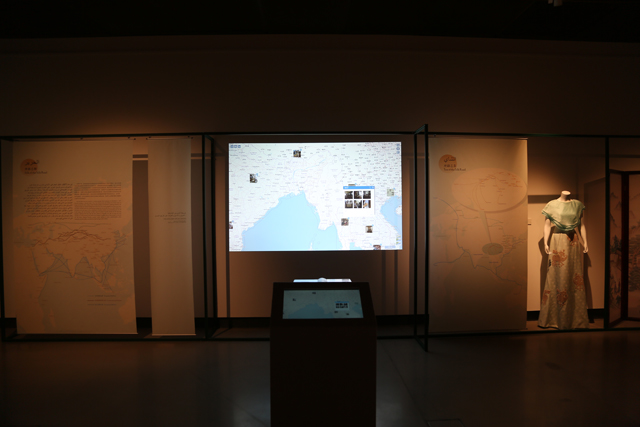
Unit 3: Technique: Techniques and Presentation
Silk, tea and porcelain, as the representatives of Chinese traditional handicrafts, coagulate the ingenuity and wisdom of generations of Chinese craftsmen. With the buzzing loom, the weaver handles with thousands of threads. With the blazing kiln fire, in eyes of kiln workers, there are green porcelains. With tender buds in the pot, tea makers retain the fragrance of tea...
التقنيات والعروض
يمثل الشاي والحرير والخزف الحرفيات التقليدية للصينيين والتي تعكس البراعة والحكمة المتوارثة عبر الأجيال، فمع النول الصاخب يغزل النساج آلاف الخيوط، وتنعكس صورة الخزف الأخضر من النيران المتوهجة في أعين الخزافين، وتعبق رائحة الشاي من البراعم التي يغلق عليها في وعاء ذي غطاء.
Buzzing Looms
It is a long time to wait for the completion of a silk product, from mulberry planting, silkworm egg cultivating, silkworm breeding and cocoon storing to the formation and making of silk threads, the production of products with various tissues and textures with various looms, dyeing,etc.
Illustrations of Sericulture and Weaving in South Song Dynasty illustrates the whole sericulture and silk making process.
النول الصاخب
تخوض المنسوجة الحريرية مرحلة طويلة حتى تكتمل، فتزرع شجرة التوت ثم تبيض دودة القز وتشق الشرنقة طريقها لتغزل خيوطا حريرية تجمع فيما بعد لينتج منها أقمشة وأنسجة مختلفة يتم صباغتها.
يوضح مخطط نسج دودة القز في جنوب سلالة أسرة سونغ تربية دودة القز الكاملة وعملية صنع الحرير

• Blazing Kiln Fire
In the long-term inheritance process, unique sintering techniques of Longquan celadon were formed, which are different from those of porcelains of other colours. Longquan Celadon is of unique features in terms of selection of raw materials, glaze preparation, modelling and kiln temperature control.
نيران الأفران المتوهجة
في عملية توريث صناعة الخزف على المدى الطويل، ابتكرت تقنيات تصنيع مختلفة منها طريقة نغيتشوان والتي تختلف تماما عن الطرق الأخرى لصناعة الخزفيات، وتتباين عملية صناعة الخزفيات بطريقة نغيتشوان بمميزاتها المتفردة من حيث اختيار المواد الخام وإعداد التزجيج، والنمذجة والتحكم في درجة حرارة الفرن.
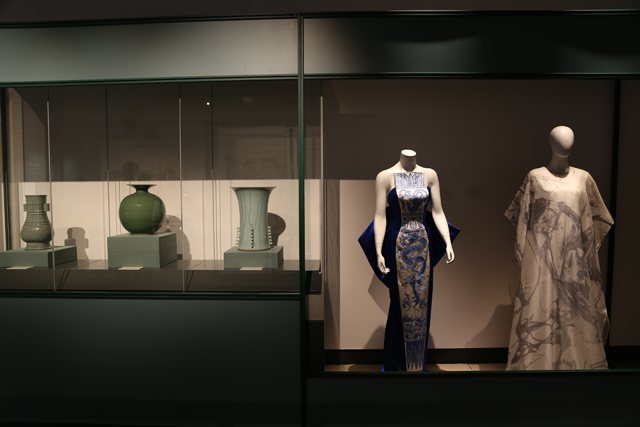
Unit 4: Utensil: Perfect Art Works
The beautiful silk, gentle celadon and elegant tea drink make up the life of ancient Chinese literati. The utensils extend unique oriental temperament and life aesthetics, which are the poetry of calligraphy and painting, the leisure in daily life, the generousness to cook tea, heat wine and listen to music and the meditative mind with a burning incense and meditation for a moment...
الآنية: العمل الفني المثالي
إن الحرير الأنيق والخزف الجميل وشراب الشاي الرائع يخلقون حياة للأدباء الصينيين القدماء؛ فتضفي الأواني الفريدة من نوعها أجواء شرقية متناغمة مع جماليات الحياة كالشعر وفن الخط والرسم، والترفيه وإعداد الشاي وتسخين النبيذ والإصغاء للموسيقى مع عبق البخور المنتشر في الأجواء الذي يأخذ العقل لحالة من التأمل للحظة.
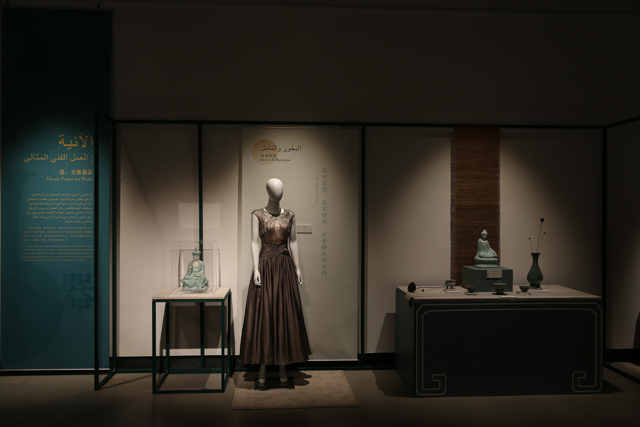
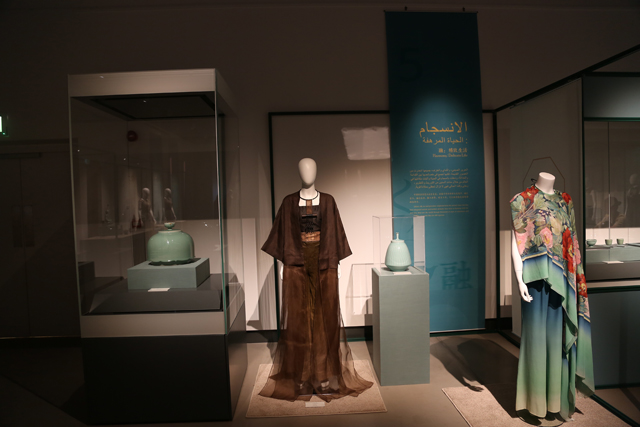
Unit 5: Harmony: Delicate Life
China’s silk, tea and porcelain originated from the ancient times, but they have integrated ancient and modern elements, have been in harmony with life, and have fitted into the world through thousands of years of inheritance and development. At present, they are still vigorous.
الانسجام: الحياة المرهفة
الحرير الصيني، والشاي والخزف، جميعها انحدرت من العصور القديمة، لكنها تجمع في خصائصها بين القدامة والحداثة، ودخلت بانسجام في الحياة وأثبتت مكانتها في العالم من خلال مئات السنين من التوريث والتطوير، وحتى وقتنا الحالي فهي لا تزال تحظى بمكانة قوية.

 Pay attention to us
×
Pay attention to us
×